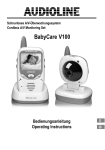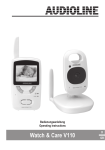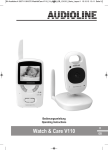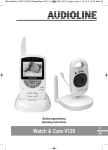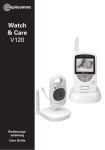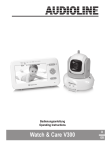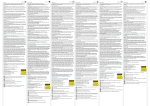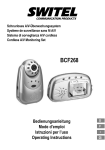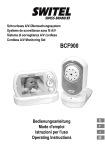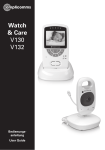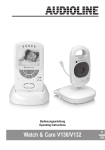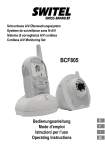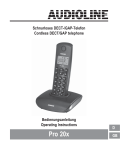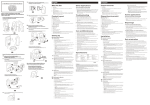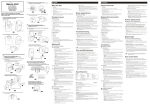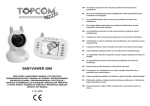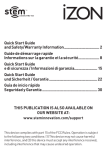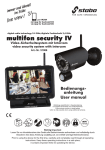Download BCF810 - Switel
Transcript
Schnurloses A/V−Überwachungssystem Système de surveillance sans fil A/V Sistema di sorveglianza A/V cordless Cordless A/V Monitoring Set BCF810 Bedienungsanleitung Mode d’emploi Istruzioni per l’uso Operating Instructions Bedienungsanleitung . . . . . . . . . . . . . . . . . . . 3 Mode d’emploi . . . . . . . . . . . . . . . . . . . . . . . 19 Istruzioni per l’uso . . . . . . . . . . . . . . . . . . . . . 35 Operating Instructions . . . . . . . . . . . . . . . . . . 51 Declaration of Conformity . . . . . . . . . . . . . . . 68 2 1 Inhaltsverzeichnis 1 2 3 Sicherheitshinweise . . . . . . . . . . . . . . . . . . . . . . . . . . . . 5 Bestimmungsgemäße Verwendung . . . . . . . . . . . . . . . . . . . Aufstellungsort und Sicherheitsinformationen . . . . . . . . . . . . Netzteil . . . . . . . . . . . . . . . . . . . . . . . . . . . . . . . . . . . . . . . Aufladbare Akkus . . . . . . . . . . . . . . . . . . . . . . . . . . . . . . . Stromausfall . . . . . . . . . . . . . . . . . . . . . . . . . . . . . . . . . . . Medizinische Geräte . . . . . . . . . . . . . . . . . . . . . . . . . . . . . Entsorgung . . . . . . . . . . . . . . . . . . . . . . . . . . . . . . . . . . . . 5 5 5 5 5 5 6 Bedienelemente und Anzeigen . . . . . . . . . . . . . . . . . . . . . 7 Monitor-Einheit (Empfänger) . . . . . . . . . . . . . . . . . . . . . . . . Kamera-Einheit (Sender) . . . . . . . . . . . . . . . . . . . . . . . . . . 7 8 Geräte in Betrieb nehmen . . . . . . . . . . . . . . . . . . . . . . . . 9 Sicherheitshinweise . . . . . . . . . . . . . . . . . . . . . . . . . . . . . . Verpackungsinhalt prüfen . . . . . . . . . . . . . . . . . . . . . . . . . . Sender anschließen und ausrichten . . . . . . . . . . . . . . . . . . 9 9 9 Betrieb mit Batterien (nicht im Lieferumfang enthalten) . . . . . . . Betrieb mit Netzteil . . . . . . . . . . . . . . . . . . . . . . . . . . . . . . . . 9 9 Empfänger anschließen . . . . . . . . . . . . . . . . . . . . . . . . . . . 10 4 Betrieb mit Netzteil . . . . . . . . . . . . . . . . . . . . . . . . . . . . . . . . Betrieb mit Akkupack . . . . . . . . . . . . . . . . . . . . . . . . . . . . . . . Gürtelclip/Standbein verwenden . . . . . . . . . . . . . . . . . . . . . . . 10 10 10 Wie bediene ich den Sender . . . . . . . . . . . . . . . . . . . . . . . 11 Sender ein−/ausschalten . . . . . . . . . . . . . . . . . . . . . . . . . . . 11 Sender anschließen und ausrichten . . . . . . . . . . . . . . . . . . 11 Nachtsicht . . . . . . . . . . . . . . . . . . . . . . . . . . . . . . . . . . . . . 11 3 Inhaltsverzeichnis 5 6 Wie bediene ich den Empfänger . . . . . . . . . . . . . . . . . . . . 12 Empfänger ein−/ausschalten . . . . . . . . . . . . . . . . . . . . . . . . Helligkeit einstellen . . . . . . . . . . . . . . . . . . . . . . . . . . . . . . Temperaturüberwachung einstellen . . . . . . . . . . . . . . . . . . . Nachtlicht ein−/ausschalten . . . . . . . . . . . . . . . . . . . . . . . . . VOX-Empfindlichkeit einstellen . . . . . . . . . . . . . . . . . . . . . . Schlaflieder wählen . . . . . . . . . . . . . . . . . . . . . . . . . . . . . . Gespräch führen . . . . . . . . . . . . . . . . . . . . . . . . . . . . . . . . Reichweite . . . . . . . . . . . . . . . . . . . . . . . . . . . . . . . . . . . . Registrierung . . . . . . . . . . . . . . . . . . . . . . . . . . . . . . . . . . . 12 12 12 12 13 13 13 13 14 Falls es Probleme gibt . . . . . . . . . . . . . . . . . . . . . . . . . . . 15 Service−Hotline . . . . . . . . . . . . . . . . . . . . . . . . . . . . . . . . . 15 Fragen und Antworten . . . . . . . . . . . . . . . . . . . . . . . . . . . . 15 7 Technische Eigenschaften . . . . . . . . . . . . . . . . . . . . . . . . 16 Technische Daten . . . . . . . . . . . . . . . . . . . . . . . . . . . . . . . 16 Konformitätserklärung . . . . . . . . . . . . . . . . . . . . . . . . . . . . 16 8 Pflegehinweise / Garantie . . . . . . . . . . . . . . . . . . . . . . . . 17 Pflegehinweise . . . . . . . . . . . . . . . . . . . . . . . . . . . . . . . . . 17 Garantie . . . . . . . . . . . . . . . . . . . . . . . . . . . . . . . . . . . . . . 17 4 Sicherheitshinweise 1 Sicherheitshinweise Lesen Sie diese Bedienungsanleitung sorgfältig durch. Bestimmungsgemäße Verwendung Das Überwachungssystem wurde zur Überwachung von Räumen entwickelt. Der Sender übermittelt von seinem Standort aus Stimmlaute und Bilder an den Empfänger. Jede andere Verwendung gilt als nicht bestimmungsgemäß. Die Verwendung des Geräts ersetzt nicht die persönliche Beaufsichtigung, z. B. eines Kindes. Der Anwender wird nicht aus seiner persönlichen Haftung entlassen. Eigenmächtige Veränderungen oder Umbauten sind nicht zulässig. Öffnen Sie das Gerät in keinem Fall selbst und führen Sie keine eigenen Reparaturversuche durch. Aufstellungsort und Sicherheitsinformationen Legen Sie den Sender niemals in das Bett oder in den Laufstall eines Babys/Kindes. Vergewissern Sie sich, dass sich der Sender und das Netzkabel immer außerhalb der Reichweite von Babys/Kindern befinden, d. h. mindestens einen Meter entfernt. Sorgen Sie während des Betriebs für ausreichende Belüftung aller Komponenten. Legen Sie keine Kissen, Handtücher oder Ähnliches auf die Geräte. Die Geräte sind nicht für den medizinischen Einsatz geeignet. Warn− oder Signaltöne von Atmungs− oder Herztonüberwachungsgeräten können nicht übertragen werden. Der Aufstellungsort hat entscheidenden Einfluss auf den einwandfreien Betrieb. Halten Sie einen Abstand von mindestens einem Meter zu elektronischen Geräten, wie z. B. Mikrowellen oder Hi-Fi−Geräten ein, da es sonst zu gegenseitiger Beeinflussung/Störung kommen kann. Vermeiden Sie Belastungen durch Rauch, Staub, Erschütterungen, Chemikalien, Feuchtigkeit, Hitze oder direkte Sonneneinstrahlung. Verwenden Sie die Geräte nicht in explosionsgefährdeten Bereichen. Netzteil Achtung: Verwenden Sie nur die mitgelieferten Steckernetzteile, da andere Netzteile das Überwachungssystem beschädigen können. Sie dürfen den Zugang zum Steckernetzteil nicht durch Möbel oder andere Gegenstände versperren. Achten Sie beim Betrieb mit einem Netzteil auf den einwandfreien Zustand der Kabel und Stecker. Abgeknickte oder durchgescheuerte Kabel sind lebensgefährlich! Wichtiger Hinweis Ihr Gerät (Empfänger) ist mit einem energieeffizienten Schaltnetzteil (Input 100~240 VAC, Output 6 VDC, 800 mA) ausgestattet. Die Nulllast beträgt ca. 0,69 W. Die durchschnittliche Effizienz beträgt ca. 66 %. Die Leistungsaufnahme beträgt ca. 1,81 W. Ihr Gerät (Sender) ist mit einem energieeffizienten Schaltnetzteil (Input 100~240 VAC, Output 6 VDC, 800 mA) ausgestattet. Die Nulllast beträgt ca. 0,69 W. Die durchschnittliche Effizienz beträgt ca. 66 %. Die Leistungsaufnahme beträgt ca. 0,93 W. 5 Sicherheitshinweise Aufladbare Akkus Achtung: Werfen Sie Akkus nicht ins Feuer. Verwenden Sie nur Akkus des gleichen Typs! Achten Sie auf die richtige Polung! Stromausfall Bei Stromausfall funktionieren die Geräte nur im Batteriebetrieb. Ziehen Sie dafür die Netzadapterstecker aus den Geräten heraus. Medizinische Geräte Achtung: Benutzen Sie die Geräte nicht in der Nähe von medizinischen Geräten. Eine Beeinflussung kann nicht völlig ausgeschlossen werden. Entsorgung Wollen Sie Ihr Gerät entsorgen, bringen Sie es zur Sammelstelle Ihres kommunalen Entsorgungsträgers (z. B. Wertstoffhof). Nach dem Elektro− und Elektronikgerätegesetz sind Besitzer von Altgeräten gesetzlich verpflichtet, alte Elektro− und Elektronikgeräte einer getrennten Abfallerfassung zuzuführen. Das Symbol bedeutet, dass Sie das Gerät auf keinen Fall in den Hausmüll werfen dürfen! Gefährdung von Gesundheit und Umwelt durch Akkus und Batterien! Akkus und Batterien nie öffnen, beschädigen, verschlucken oder in die Umwelt gelangen lassen. Sie können giftige und umweltschädliche Schwermetalle enthalten. Sie sind gesetzlich verpflichtet, Akkus und Batterien beim batterievertreibenden Handel sowie bei zuständigen Sammelstellen, die entsprechende Behälter bereitstellen, sicher zu entsorgen. Die Entsorgung ist unentgeltlich. Die Symbole bedeuten, dass Sie Akkus und Batterien auf keinen Fall in den Hausmüll werfen dürfen und sie über Sammelstellen der Entsorgung zugeführt werden müssen. Verpackungsmaterialien entsorgen Sie entsprechend den lokalen Vorschriften. 6 Bedienelemente und Anzeigen 2 Bedienelemente und Anzeigen Die Tasten Ihres Gerätes werden in dieser Bedienungsanleitung nachfolgend mit vereinheitlichten umrandeten Symbolen dargestellt. Leichte Abweichungen der Tastensymbole Ihres Gerätes gegenüber den hier verwendeten Tastensymbolen sind daher möglich. Monitor-Einheit (Empfänger) 1 2 13 3 13 3 12 4 5 12 4 11 10 6 7 9 8 14 15 17 16 1 2 3 4 5 6 7 8 9 10 11 12 13 14 15 16 17 Antenne Geräuschpegel-LEDs Wiedergabe/Pause Auswahl Schlaflieder Sprechtaste Menütaste VOX-LED Lautsprecher Mikrofon Power-LED Ein-/Ausschalter Verringern von Lautstärke und Helligkeit / Menüauswahl Erhöhen von Lautstärke und Helligkeit / Menüauswahl Gürtelclip/Standbein Akkufach Ladeschale Ladekontakte 7 Bedienelemente und Anzeigen Kamera-Einheit (Sender) 23 18 19 24 22 21 27 20 25 26 28 26 18 19 20 21 22 23 24 25 26 27 28 8 Nachtlicht Lichtsensor Power-LED Mikrofon Objektiv Antenne Lautsprecher Temperatursensor Anschluss für Netzteil Ein-/Ausschalter ON/OFF Batteriefach Geräte in Betrieb nehmen 3 Geräte in Betrieb nehmen Sicherheitshinweise Achtung: Lesen Sie vor der Inbetriebnahme unbedingt die Sicherheitshinweise in Kapitel 1. Die übertragenen Daten (Bild und/oder Töne) sind im Empfangsbereich öffentlich zu empfangen! Verpackungsinhalt prüfen 2 Zum Lieferumfang gehören: eine Kamera−Einheit (Sender) eine Monitor−Einheit (Empfänger) mit Gürtelclip/Standbein ein aufladbares Akkupack für den Empfänger ein Netzteil für den Sender eine Ladeschale mit Netzteil für den Empfänger eine Bedienungsanleitung Sender anschließen und ausrichten Achtung: Stellen Sie den Sender mit einem Mindestabstand von 1 m zu anderen elektronischen Geräten auf, da es sonst zu gegenseitigen Störungen kommen kann. Richten Sie das Oberteil des Senders auf das zu überwachende Baby bzw. Objekt aus. Überprüfen Sie, ob das Baby bzw. Objekt geeignet auf dem Empfänger angezeigt wird. Betrieb mit Batterien (nicht im Lieferumfang enthalten) Öffnen Sie das Batteriefach auf der Unterseite des Senders mit einem kleinen Schraubendreher. Setzen Sie die Batterien polungsrichtig ein. Folgen Sie dazu den Abbildungen im Batteriefach. Schließen Sie das Batteriefach wieder. Der Sender wird mit 4 AAA Alkaline Batterien (nicht im Lieferumfang enthalten) betrieben. Der Sender hat keine Ladefunktion. Setzen Sie die Batterien zuerst ein, bevor Sie das Netzteil anschließen. Bei geringer Batterieleistung blinkt die Power-LED langsam. Die Batterien müssen ausgewechselt werden. Betrieb mit Netzteil Schließen Sie den Sender wie auf der Skizze abgebildet an. Verwenden Sie aus Sicherheitsgründen nur das mitgelieferte Netzteil. Netzsteckdose 9 Geräte in Betrieb nehmen Empfänger anschließen Achtung: Stellen Sie den Empfänger mit einem Mindestabstand von 1 m zu anderen elektronischen Geräten auf, da es sonst zu gegenseitigen Störungen kommen kann. Betrieb mit Netzteil Schließen Sie den Empfänger wie auf der Skizze abgebildet an. Verwenden Sie aus Sicherheitsgründen nur das mitgelieferte Netzteil. Netzsteckdose Betrieb mit Akkupack 1. Drehen Sie den Gürtelclip nach oben. 2. Öffnen Sie das Akkufach auf der Rückseite des Empfängers. 3. Setzen Sie das Akkupack polungsrichtig ein. 4. Schließen Sie das Akkufach wieder. 5. Drehen Sie den Gürtelclip wieder nach unten. Der Empfänger wird mit einem 3,6 V, 930 mAh Akkupack betrieben. Das Akkupack kann direkt im Gerät geladen werden, wenn dieses in der Ladestation steht. Im Ladezustand leuchtet die Power-LED rot. Bei geringer Akkupackleistung blinkt die Power-LED. Das Akkupack muss dann geladen werden. Gürtelclip/Standbein verwenden Wenn Sie den Gürtelclip/Standbein nach oben drehen, können Sie es als Gürtelclip verwenden. In der unteren Position kann der Gürtelclip als Standbein benutzt werden. 10 Wie bediene ich den Sender 4 Wie bediene ich den Sender Überprüfen Sie vor jedem Einsatz die einwandfreie Funktion von Sender und Empfänger. Sender ein−/ausschalten Stellen Sie den Sender für die Überwachung an einem günstigen Ort auf und richten Sie das Objektiv auf den Beobachtungsbereich ein. Diesen Schalter in die Position ON schieben. Die Power-LED leuchtet grün. Der Sender ist jetzt betriebsbereit. Zum Ausschalten diesen Schalter in die Position OFF schieben. Bei geringer Batterieladung blinkt die Power-LED. Wechseln Sie die 4 AAA Alkaline Batterien. Sender anschließen und ausrichten Achtung: Stellen Sie den Sender mit einem Mindestabstand von 1 m zu anderen elektronischen Geräten auf, da es sonst zu gegenseitigen Störungen kommen kann. Richten Sie das Oberteil des Senders auf das zu überwachende Baby bzw. Objekt aus. Überprüfen Sie, ob das Baby bzw. Objekt geeignet auf dem Empfänger angezeigt wird. Nachtsicht Der Sender ist mit 4 Infrarot−Dioden ausgestattet. Dadurch ist die Bildübertragung aus unbeleuchteten Bereichen möglich. Die Nachtsichtfunktion wird automatisch aktiviert, wenn die Lichtverhältnisse es erfordern. Bei aktivierter Nachtsichtfunktion ist die Bildschirmdarstellung am Empfänger schwarz−weiß. 11 Wie bediene ich den Empfänger 5 Wie bediene ich den Empfänger Überprüfen Sie vor jedem Einsatz die einwandfreie Funktion von Sender und Empfänger. Empfänger ein−/ausschalten Diese Taste gedrückt halten, bis 2 Signaltöne erklingen. Danach erscheint zuerst das Logo und dann die Bildübertragung vom Sender. Zum Ausschalten diese Taste ca. 1 Sek. gedrückt halten. Bei geringer Akkupackleistung blinkt die Power-LED. Helligkeit einstellen Diese Taste 1 x drücken. Dieses Symbol wird für einige Sekunden im Display angezeigt. Mit diesen Tasten die Helligkeit in 5 Stufen einstellen. Temperaturmessung einstellen WICHTIGER HINWEIS Die ideale Raumtemperatur während des Schlafens des/der Babies beträgt 16° - 18°C. Bitte stellen Sie die Raumtemperatur entsprechend ein. Diese Taste 2 x drücken. Dieses Symbol wird für einige Sekunden im Display angezeigt. Mit diesen Tasten die Temperaturmessung auf OFF, °C oder °F einstellen. 18°C Während der Temperaturmessung wird die Tempeartur z. B. in °C angezeigt. Nachtlicht ein−/ausschalten Diese Taste 3 x drücken. Dieses Symbol wird für einige Sekunden im Display angezeigt. Mit diesen Tasten das Nachtlicht des Senders ein- oder ausschalten. 12 Wie bediene ich den Empfänger VOX1-Empfindlichkeit einstellen Durch die VOX1-Funktion (Geräuscherkennung) beginnt das System automatisch mit der Übertragung vom Sender zum Empfänger, wenn eine Stimme oder ein Geräusch erkannt wird. Diese Taste 5 x drücken. Dieses Symbol wird für einige Sekunden im Display angezeigt. Mit diesen Tasten VOX OFF oder die Empfindlichkeit in 5 Stufen einstellen. Wenn eine der 5 Stufen eingestellt ist, leuchtet die VOX LED rot und das Display erlischt nach 10 Sekunden. Das Display wird wieder eingeschaltet, wenn ein Geräusch erkannt oder eine Taste am Empfänger betätigt wird. 1 VOX: Voice Operated Transmission = Geräuscherkennung Schlaflieder wählen Diese Taste auf der rechten Geräteseite drücken. Dieses Symbol wird dauerhaft im Display angezeigt. Mit dieser Taste 5 verschiedene Schlaflieder (1-5) auswählen. Wenn keine Nummer angezeigt wird, werden alle Schlaflieder nacheinander abgespielt. Mit diesen Tasten die Lautstärke in 5 Stufen einstellen. Die Lautstärke kann am Sender und am Empfänger gleichzeitig verändert werden. Dieses Symbol wird während der Lautstärkeeinstellung angezeigt. 13 Wie bediene ich den Empfänger Gespräch führen Diese Taste gedrückt halten. Dieses Symbol wird im Display angezeigt. In das Mikrofon sprechen, um mit dem Baby/Partner zu sprechen. Während des Gesprächs werden eventuell abgespielte Schlaflieder stummgeschaltet. Reichweite Dieses Symbol blinkt im Display, wenn die Reichweite zwischen Sender und Empfänger überschritten wurde. Bewegen Sie sich mit dem Empfänger wieder in die Nähe des Senders. Registrierung Empfänger und Sender sind angemeldet. Bei Bedarf können Sie eine Anmeldung auch manuell durchführen: Sender/Empfänger 1 Sender ausschalten. Schalter auf Position OFF. Falls erforderlich, die Batterien aus dem Sender für einige Sekunden entfernen. 2 Lichtsensor des Senders mit einem schwarzen Stoff abdecken und Sender einschalten. Position ON. 3 Bei eingeschaltetem Empfänger diese Taste am Empfänger einige Sekunden gedrückt halten. C1 4 Dieses Symbol erscheint im Display. 5 Die Power LED des Senders blinkt schnell ca. 15 Sekunden lang. 6 Diese Taste am Empfänger zur Bestätigung drücken. 7 Erst erscheint C1...., danach C1...X. Nach der erfolgreichen Verbindung wird im Display das vom Objektiv erfasste Bild angezeigt. Falls C1...X (Anmeldung fehlgeschlagen) erscheinen sollte, müssen Sie evtl. die Batterien aus dem Sender für einige Sekunden entfernen. 14 Falls es Probleme gibt 6 Falls es Probleme gibt Service−Hotline Haben Sie Probleme mit Ihrem Gerät, kontrollieren Sie zuerst die folgenden Hinweise. Bei technischen Problemen können Sie sich an unsere Service−Hotline unter Tel. 0900 00 1675 innerhalb der Schweiz (Kosten Swisscom bei Drucklegung: CHF 2.60/min) wenden. Bei Garantieansprüchen wenden Sie sich an Ihren Fachhändler. Die Garantiezeit beträgt 2 Jahre. Fragen und Antworten Fragen Antworten Keine Funktion − Sender und/oder Empfänger sind nicht eingeschaltet. − Akkupack/Batterien sind leer oder defekt. − Netzadapter sind nicht angeschlossen. Kein Empfang − Sender und Empfänger sind nicht angemeldet. − Der Abstand des Senders, z. B. zum Baby, ist zu groß. Beachten Sie den Mindestabstand von einem Meter. − Der Abstand zwischen Empfänger und Sender ist zu groß. − Die VOX-Empfindlichkeit ist zu niedrig eingestellt. Empfangsstörungen − Der Abstand zwischen Empfänger und Sender ist zu groß. − Akku−/Batterieleistung ist zu gering. − Andere elektronische Geräte stören das Übertragungsfeld. Pfeifton (Rückkopplung) − Vergrößern Sie die Entfernung zwischen Empfänger und Sender. − Verringern Sie die Lautstärke am Empfänger. Rauschen − Akku−/Batterieleistung ist zu gering. Bild− aber keine Tonübertragung − Die Lautstärke ist zu gering eingestellt. Bild wird schwarz−weiß dargestellt − Die Nachtsichtfunktion ist aktiv. Das Akkupack im Empfänger wird nicht geladen − Der Netzadapter ist nicht angeschlossen. 15 Technische Eigenschaften 7 Technische Eigenschaften Technische Daten Merkmal Wert Kamera (Sender) Buchse: 6 V DC Sensor: 1 Nachtlichtsensor IR−Dioden: 4 Monitor (Empfänger) Bildschirm: 2,4" LC−Display Buchse: 6 V DC Stromversorgung (Empfänger) Netzteil Sure Power SW−060080EU, Input: 100-240 VAC, 50-60Hz, 200 mA Netzteil, Output: 6 VDC, 800 mA oder Akkupack NiMH 3,6 V, 930 mAh bis zu 16 h Ladezeit Akkupack Stromversorgung (Sender) Netzteil Sure Power SW−060080EU, Input: 100-240 VAC, 50-60Hz, 200 mA Netzteil, Output: 6 VDC, 800 mA oder 4 Alkaline Batterien Typ: AAA Reichweite Bis zu 150 Metern unter optimalen Bedingungen. In Gebäuden wird die Reichweite durch Wände, Türen usw. verringert. Frequenzbereich 2.4GHz Zulässige Umgebungstemperatur 0° C bis 40° C Sendeleistung (TX PA Power) 15 ~ 17 dBm Konformitätserklärung Dieses Gerät erfüllt die Anforderungen der EU−Richtlinie: 1999/5/EG Richtlinie über Funkanlagen und Telekommunikationsendeinrichtungen und die gegenseitige Anerkennung ihrer Konformität. Die Konformität mit der o. a. Richtlinie wird durch das CE−Zeichen auf dem Gerät bestätigt. Für die komplette Konformitätserklärung nutzen Sie bitte den kostenlosen Download von unserer Website www.switel.com . 16 Pflegehinweise / Garantie 8 Pflegehinweise / Garantie Pflegehinweise Reinigen Sie die Gehäuseoberflächen mit einem weichen und fusselfreien Tuch. Verwenden Sie keine Reinigungsmittel oder Lösungsmittel. Garantie SWITEL − Geräte werden nach den modernsten Produktionsverfahren hergestellt und geprüft. Ausgesuchte Materialien und hoch entwickelte Technologien sorgen für einwandfreie Funktion und lange Lebensdauer. Die Garantie gilt nicht für die in den Produkten verwendeten Batterien, Akkus oder Akkupacks. Die Garantiezeit beträgt 24 Monate, gerechnet vom Tage des Kaufs. Innerhalb der Garantiezeit werden alle Mängel, die auf Material− oder Herstellungsfehler zurückzuführen sind, kostenlos beseitigt. Der Garantieanspruch erlischt bei Eingriffen durch den Käufer oder durch Dritte. Schäden, die durch unsachgemäße Behandlung oder Bedienung, natürliche Abnutzung, durch falsches Aufstellen oder Aufbewahren, durch unsachgemäßen Anschluss oder Installation sowie durch höhere Gewalt oder sonstige äußere Einflüsse entstehen, fallen nicht unter die Garantieleistung. Wir behalten uns vor, bei Reklamationen die defekten Teile auszubessern, zu ersetzen oder das Gerät auszutauschen. Ausgetauschte Teile oder ausgetauschte Geräte gehen in unser Eigentum über. Schadenersatzansprüche sind ausgeschlossen, soweit sie nicht auf Vorsatz oder grober Fahrlässigkeit des Herstellers beruhen. Sollte Ihr Gerät dennoch einen Defekt innerhalb der Garantiezeit aufweisen, wenden Sie sich bitte unter Vorlage Ihrer Kaufquittung ausschließlich an das Geschäft, in dem Sie Ihr SWITEL − Gerät gekauft haben. Alle Gewährleistungsansprüche nach diesen Bestimmungen sind ausschließlich gegenüber Ihrem Fachhändler geltend zu machen. Nach Ablauf von zwei Jahren nach Kauf und Übergabe unserer Produkte können Gewährleistungsrechte nicht mehr geltend gemacht werden. 17 Notizen Notizen 18 3 Table des matières 1 2 Consignes de sécurité . . . . . . . . . . . . . . . . . . . . . . . . . . . 21 Utilisation conforme aux prescriptions . . . . . . . . . . . . . . . . . Lieu d’installation et informations de sécurité . . . . . . . . . . . . Bloc secteur . . . . . . . . . . . . . . . . . . . . . . . . . . . . . . . . . . . Piles rechargeables . . . . . . . . . . . . . . . . . . . . . . . . . . . . . . Panne de courant . . . . . . . . . . . . . . . . . . . . . . . . . . . . . . . Appareils médicaux . . . . . . . . . . . . . . . . . . . . . . . . . . . . . . 21 21 21 22 22 22 Éléments de manipulation et affichages . . . . . . . . . . . . . . . 23 Unité écran (récepteur) . . . . . . . . . . . . . . . . . . . . . . . . . . . 23 Unité appareil photo (émetteur) . . . . . . . . . . . . . . . . . . . . . . 24 3 Mettre les appareils en service . . . . . . . . . . . . . . . . . . . . . 25 Remarques concernant la sécurité . . . . . . . . . . . . . . . . . . . 25 Vérifier le contenu de l’emballage . . . . . . . . . . . . . . . . . . . . 25 Raccorder l’émetteur et l’aligner . . . . . . . . . . . . . . . . . . . . . 25 Fonctionnement avec piles rechargeables (non fournies) . . . . . Fonctionnement par le bloc d’alimentation . . . . . . . . . . . . . . . . 25 25 Raccorder le récepteur . . . . . . . . . . . . . . . . . . . . . . . . . . . . 26 4 Fonctionnement par le bloc d’alimentation . . . . . . . . . . . . . . . . Fonctionnement avec un pack de piles rechargeables . . . . . . . Utiliser le clip de ceinture / le support . . . . . . . . . . . . . . . . . . . 26 26 26 Comment fonctionne mon émetteur . . . . . . . . . . . . . . . . . 27 Allumer/Éteindre l’émetteur . . . . . . . . . . . . . . . . . . . . . . . . 27 Raccorder l’émetteur et l’aligner . . . . . . . . . . . . . . . . . . . . . 27 Vue nocturne . . . . . . . . . . . . . . . . . . . . . . . . . . . . . . . . . . . 27 19 Table des matières 5 Comment fonctionne mon récepteur . . . . . . . . . . . . . . . . . 28 Allumer/Éteindre le récepteur . . . . . . . . . . . . . . . . . . . . . . . Régler la luminosité . . . . . . . . . . . . . . . . . . . . . . . . . . . . . . Régler la mesure de la température . . . . . . . . . . . . . . . . . . Allumer/Éteindre la veilleuse . . . . . . . . . . . . . . . . . . . . . . . . VOX-Régler la sensibilité . . . . . . . . . . . . . . . . . . . . . . . . . . Sélectionner les berceuses . . . . . . . . . . . . . . . . . . . . . . . . . Avoir une communication . . . . . . . . . . . . . . . . . . . . . . . . . . Portée . . . . . . . . . . . . . . . . . . . . . . . . . . . . . . . . . . . . . . . . Déclaration . . . . . . . . . . . . . . . . . . . . . . . . . . . . . . . . . . . . 28 28 28 28 29 29 30 30 30 En cas de problèmes . . . . . . . . . . . . . . . . . . . . . . . . . . . . 31 6 Hotline de service . . . . . . . . . . . . . . . . . . . . . . . . . . . . . . . 31 Questions et réponses . . . . . . . . . . . . . . . . . . . . . . . . . . . . 31 7 Caractéristiques techniques . . . . . . . . . . . . . . . . . . . . . . . 32 Données techniques . . . . . . . . . . . . . . . . . . . . . . . . . . . . . 32 Déclaration de conformité . . . . . . . . . . . . . . . . . . . . . . . . . . 32 8 Remarques d’entretien / Garantie . . . . . . . . . . . . . . . . . . . 33 Remarques d’entretien . . . . . . . . . . . . . . . . . . . . . . . . . . . . 33 Garantie . . . . . . . . . . . . . . . . . . . . . . . . . . . . . . . . . . . . . . 33 20 Consignes de sécurité 1 Consignes de sécurité Lisez très attentivement ce mode d’emploi. Utilisation conforme aux prescriptions Le système de surveillance a été conçu pour la surveillance de pièces. Depuis sa position, l’émetteur transmet des voix et des images au récepteur. Tout autre utilisation est considérée comme non conforme à l’usage. L’utilisation de cet appareil ne remplace pas la surveillance personnelle, p. ex. d’un enfant. L’utilisateur n’est pas dégagé de son obligation personnelle. Des modifications ou changements effectués d’un propre gré ne sont pas autorisés. N’ouvrez en aucun cas l’appareil et n’effectuez aucun essai de réparation vous−même. Lieu d’installation et informations de sécurité Ne déposez jamais l’émetteur dans le lit ou dans le parc d’un bébé/d’un enfant. Assurez−vous que cet émetteur et le câble de réseau ne se trouvent jamais à portée du bébé/de l’enfant, c. à. d. que vous devez respecter une distance d’au moins un mètre. Pendant le fonctionnement de l’appareil, veillez à une aération suffisante de tous les composants. Ne posez pas de coussins, de serviettes éponge ou d’autres choses semblables dessus. Ce genre d’appareil ne convient pas pour une utilisation médicale. Des signaux d’avertissement et des signaux sonores d’appareils respiratoires ou de surveillance des bruits du coeur ne peuvent pas être transmis. Le lieu d’installation a une influence décisive sur leur fonctionnement irréprochable. Maintenez und distance d’au moins un mètre par rapport aux appareils électroniques tels que microondes ou appareils Hifi, un risque d’interaction/de perturbations pouvant sinon être engendré. Évitez les nuisances causées par la fumée, la poussière, les vibrations, les produits chimiques, l’humidité, la grande chaleur ou un ensoleillement direct. N’utilisez pas les appareils dans des pièces exposées aux explosions. Bloc secteur Attention : N’utilisez que les blocs secteur enfichables fournis avec l’appareil, d’autres blocs pouvant endommager le système de surveillance. Vous ne devez pas bloquer l’accès au bloc secteur par des meubles ou d’autres objets. En cas de fonctionnement avec un bloc d’alimentation, veiller à ce que l’état des câbles et des fiches soit irréprochable. Des câbles rompus par une pliure ou abimés présentent un danger de mort ! Indication importante Votre appareil (récepteur) est équipé d’un bloc secteur à efficience énergique (entrée 100~240 VAC, sortie 6 VDC, 800 mA). La puissance nulle est d’env. 0,69 W. L’efficience moyenne est d’env. 66 %. La puissance absorbée est d’env. 1,81 W. Votre appareil (émetteur) est équipé d’un bloc secteur à efficience énergique (entrée 100~240 VAC, sortie 6 VDC, 800 mA). La puissance nulle est d’env. 0,69 W. L’efficience moyenne est d’env. 66 %. La puissance absorbée est d’env. 0,93 W. 21 Consignes de sécurité Piles rechargeables Attention : Ne jetez jamais les piles rechargeables dans le feu. N’utilisez que des piles rechargeables du même type ! Observez une polarisation correcte ! Panne de courant En cas de panne de courant, les appareils fonctionnent uniquement avec une alimentation par pile. Retirez alors les fiches de l’adaptateur des appareils. Appareils médicaux Attention : N’utilisez pas les appareils à proximité d’appareils médicaux. Leur influence sur ce genre d’appareils ne peut pas être entièrement exclue. Élimination Si vous voulez vous séparer de votre appareil, veuillez l’apporter au centre de collecte de l’organisme d’élimination des déchets de votre commune (par ex. centre de recyclage). D’après la loi relative aux appareils électriques et électroniques, les propriétaires d’appareils usagés sont tenus de mettre tous les appareils électriques et électroniques usagés dans un collecteur séparé. L’icône ci−contre signifie que vous ne devez en aucun cas jeter votre appareil dans les ordures ménagères ! Mise en danger de l’homme et l’environnement causée par les piles et les piles rechargeables ! Ne jamais ouvrir, endommager, avaler les piles rechargeables et les piles ou ne jamais faire pénétrer leur contenu dans l’environnement. Elles peuvent contenir des métaux lourds toxiques et nuisibles pour celui−ci. Vous êtes tenus par la loi d’éliminer vos piles rechargeables et piles auprès d’un revendeur de piles ainsi qu’auprès de centres de collecte responsables de leur élimination qui mettent des conteneurs adéquats à disposition. L’élimination des piles est gratuite. L’icône ci−contre signifie que vous ne devez en aucun cas jeter les piles rechargeables et piles dans les ordures ménagères, mais que vous devez les éliminer auprès de centres de collecte. Éliminez les fournitures d’emballage conformément au règlement local. 22 Éléments de manipulation et affichages 2 Éléments de manipulation et affichages Dans ce mode d’emploi, les touches de votre appareil seront représentées par la suite par des icônes encadrées standardisées. Il peut donc y avoir de légères différences entre les icônes des touches de votre appareil et celles des touches utilisées ici. Unité écran (récepteur) 1 2 13 3 13 3 12 4 5 12 4 11 10 6 7 9 8 14 15 17 16 1 2 3 4 5 6 7 8 9 10 11 12 13 14 15 16 17 Antenne LEDs Niveau sonore Écoute / Pause Sélection berceuses Touche de conversation Touche de menu LED VOX Haut−parleur Microphone LED Power Interrupteur allumé / éteint Diminution du volume sonore et de la luminosité / Sélection de menu Augmentation du volume sonore et de la luminosité / Sélection de menu Clip de ceinture / Support récepteur Compartiment à piles rechargeables Coupe de chargement Contacts de chargement 23 Éléments de manipulation et affichages Unité appareil photo (émetteur) 23 18 19 24 22 21 27 20 25 26 28 26 18 19 20 21 22 23 24 25 26 27 28 24 Veilleuse Détecteur de lumière DEL Power Microphone Objectif Antenne Haut−parleur Détecteur de température Raccordement pour le bloc secteur Interrupteur alllumé/éteint ON/OFF Compartiment à piles Mettre les appareils en service 3 Mettre les appareils en service Remarques concernant la sécurité Attention : Avant de mettre votre appareil en service, lisez impérativement les consignes de sécurité mentionnées au chapitre 1. Les données transmises (image) et/ou voix doivent être reçues publiquement dans la zone desservie ! Vérifier le contenu de l’emballage 4 Les éléments suivants font partie de la livraison : une unité appareil photo (émetteur) une unité écran (récepteur) avec clip de ceinture/support un pack de piles rechargeables pour le récepteur un bloc secteur pour l’émetteur une coupe de chargement avec bloc secteur pour le récepteur un mode d’emploi Raccorder l’émetteur et l’aligner Attention : Posez l’émetteur à une distance minimum d’un mètre par rapport aux autres appareils électroniques pour éviter d’éventuelles interactions. Dirigez la partie supérieure de l’émetteur vers le bébé ou l’objet à surveiller. Contrôlez si le bébé ou l’objet est affiché comme il faut sur le récepteur. Fonctionnement avec piles rechargeables (non fournies) Ouvrir le compartiment à piles situé sous l’émetteur avec un petit tournevis. Placez les piles en veillant à une polarité correcte. Suivre les croquis du compartiment à piles. Refermez le compartiment. L’émetteur fonctionne avec 4 piles AAA alcalines rechargeables (non fournies). L’émetteur ne peut pas charger. Placez d’abord les piles avant de raccorder le bloc secteur. Lorsque la puissance de la pile est faible, la LED Power clignote lentement. Les piles rechargeables doivent être remplacées. Fonctionnement par le bloc d’alimentation Raccordez l’émetteur comme représenté sur le croquis. Pour des questions de sécurité, n’utilisez que le bloc secteur fourni avec l’appareil. Prise réseau 25 Mettre les appareils en service Raccorder le récepteur Attention : Posez le récepteur à une distance minimum d’un mètre par rapport aux autres appareils électroniques pour éviter d’éventuelles interactions. Fonctionnement par le bloc d’alimentation Raccordez le récepteur comme représenté sur le croquis. Pour des questions de sécurité, n’utilisez que le bloc secteur fourni avec l’appareil. Prise réseau Fonctionnement avec un pack de piles rechargeables 6. Tournez le clip de ceinture vers le haut. 7. Ouvrez le compartiment à piles situés sur le côté arrière du récepteur. 8. Placez le pack en veillant à une polarité correcte. 9. Refermez le compartiment. 10. Tournez le clip de ceinture vers le bas. Le récepteur fonctionne avec un pack de piles rechargeables de 3,6 V, 930 mAh. Le pack peut être chargé directement dans l’appareil si celui−ci se trouve dans le chargeur. En charge, la LED Power est allumée rouge. Lorsque la puissance du pack de piles est faible, la LED Power clignote. Il faut alors le charger. Utiliser le clip de ceinture / le support Si vous tournez le clip de ceinture / l’appui vers le haut vous pouvez vous en servir comme clip. À la position inférieure, le clip de ceinture peut être utilisé comme support. 26 Comment fonctionne mon émetteur 4 Comment fonctionne mon émetteur Avant chaque utilisation, veuillez vous assurez que l’émetteur et le récepteur fonctionnent de façon irréprochable. Allumer/Éteindre l’émetteur Pour la surveillance, placez l’émetteur à un endroit favorable et dirigez l’objectif sur l’espace de surveillance. Pousser cet interrupteur à la position ON . La DEL Power devient verte. L’émetteur est maintenant prêt à fonctionner. Pour éteindre l’émetteur, pousser cet interrupteur à la position OFF. Lorsque les piles sont peu chargées, la LED Power clignote. Changer les 4 piles acalines AAA rechargeables. Raccorder l’émetteur et l’aligner Attention : Posez l’émetteur à une distance minimum d’un mètre par rapport aux autres appareils électroniques pour éviter d’éventuelles interactions. Dirigez la partie supérieure de l’émetteur vers le bébé ou l’objet à surveiller. Contrôlez si le bébé ou l’objet est affiché comme il faut sur le récepteur. Vue nocturne L’émetteur est équipé de 4 diodes infrarouge. Ainsi la transmission de l’image de zones non éclairées est−elle possible. La fonction vue nocturne est automatiquement activée si la luminosité le requiert. Si la fonction vue nocturne est activée, la représentation sur l’écran du récepteur est en noir et blanc. 27 Comment fonctionne mon récepteur 5 Comment fonctionne mon récepteur Avant chaque utilisation, veuillez vous assurez que l’émetteur et le récepteur fonctionnent de façon irréprochable. Allumer/Éteindre le récepteur Maintenir cette touche appuyée jusqu’à ce que 2 signaux sonores se fassent entendre. Ensuite s’affichent le logo et la transmission de l’image depuis l’émetteur. Maintenir cette touche appuyée env. 1 sec. pour éteindre le récepteur. Lorsque la puissance du pack de piles est faible, la LED Power clignote. Régler la luminosité Appuyer 1 x sur cette touche. Cette icône s’affiche quelques secondes sur l’écran. Ces touches vous permettent de régler la luminosité sur 5 niveaux. Régler la mesure de la température INDICATION IMPORTANTE La température de la pièce idéale pendant le sommeil du/des bébés est de 16° - 18°C. Veuillez régler la température dans cette plage. Appuyer 2 x sur cette touche. Cette icône s’affiche quelques secondes sur l’écran. Ces touches vous permettent de régler la mesure de la température sur OFF, °C ou °F. 18°C Pendant la mesure de la température, celle−ci est par exemple affichée en °C. Allumer/Éteindre la veilleuse Appuyer 3 x sur cette touche. Cette icône s’affiche quelques secondes sur l’écran. Ces touches vous permettent d’allumer ou d’éteindre la veilleuse de l’émetteur. 28 Comment fonctionne mon récepteur VOX1-Régler la sensibilité La fonction VOX1 (détection de bruits) permet au système de commencer automatiquement la transmission de l’émetteur au récepteur lorsqu’il reconnaît une voix ou un bruit. Appuyer 5 x sur cette touche. Cette icône s’affiche quelques secondes sur l’écran. Ces touches vous permettent de régler VOX OFF ou la sensibilité sur 5 niveaux. Lorsque l’un des 5 niveaux est réglé, la LED VOX rouge s’allume et l’écran s’éteint au bout de 10 secondes. L’écran s’allume à nouveau si un bruit est détecté ou si vous appuyez sur une touche du récepteur. 1 VOX : Voice Operated Transmission = détection de bruits Sélectionner les berceuses Appuyer sur cette touche située sur le côté droit du récepteur. Cette icône est toujours affichée sur l’écran. Cette touche vous permet de sélectionner 5 berceuses différentes (1-5). Si aucun numéro ne s’affiche, les 5 berceuses seront jouées l’une après l’autre. Ces touches vous permettent de régler 5 degrés de niveau sonore. Vous pouvez modifier le volume simultanément sur l’émetteur et le récepteur. Cette icône s’affiche pendant le réglage du volume. 29 Comment fonctionne mon récepteur Avoir une communication Maintenir cette touche appuyée. Cette icône s’affiche sur l’écran. Parler dans le micro pour parler avec le bébé/le partenaire. Les berceuses sont éventuellement mises sur silencieux pendant la communication. Portée Cette icône clignote sur l’écran quand la portée entre l’émetteur et le récepteur a été dépassée. Déplacez−vous de nouveau avec votre récepteur vers l’émetteur. Déclaration Destinataire et émetteur sont déclarés. Au besoin, vous pouvez les déclarer manuellement : Émetteur/Récepteur 1 Éteindre l’émetteur. Interrupteur en position OFF. Si nécessaire, retirer les piles de l’émetteur pendant quelques secondes. 2 Couvrir le détecteur de lumière de l’émetteur avec une étoffe noire et allumer l’émetteur. Position ON. 3 Maintenir cette touche appuyée quelques secondes avec récepteur allumé. C1 4 Cette icône s’affiche à l’écran. 5 La LED Power de l’émetteur clignote rapidement pendant env. 15 secondes. 6 Appuyer sur cette touche du récepteur pour confirmer. 7 D’abord s’affiche C1...., puis C1...X. La connexion réussie, l’image saisie par l’objectif est affichée à l’écran. AU cas où C1...X (inscription échouée) s’afficherait, vous devez éventuellement retirer les piles de l’émetteur pendant quelques secondes. 30 En cas de problèmes 6 En cas de problèmes Hotline de service Si vous avez des problèmes avec votre téléphone, contrôlez d’abord les indications suivantes. S’il s’agit de problèmes techniques, vous pouvez vous adresser à notre hotline de service en Suisse au numéro de tel. 0900 00 1675 (frais Swisscom à la date d’impression de ce manuel : CHF 2.60/min). Si vous avez des droits de garantie, adressez−vous à votre revendeur. La durée de la garantie est de 2 ans. Questions et réponses Questions Réponses Pas de fonction − Émetteur et/ou récepteur non branché. − Les piles/piles rechargeables sont vides ou défectueuses. − Les blocs d’alimentation ne sont pas raccordés. Pas de réception − Récepteur et émetteur ne sont pas déclarés. − La distance de l’émetteur, par rapport au bébé p. ex., est trop grande. Respectez la distance minimum d’un mètre. − La distance entre le récepteur et l’émetteur est trop grande. − La sensibilité VOX est réglée trop basse. Perturbations dans la réception − La distance entre le récepteur et l’émetteur est trop grande. − La capacité des piles rechargeables/piles est trop faible. − D’autres appareils électroniques perturbent le champ de transmission. Sifflement (rétroaction) − Augmentez la distance entre le récepteur et l’émetteur. − Diminuez le volume du récepteur. Grésillements − La capacité des piles rechargeables/piles est trop faible. Transmission de l’image mais pas du son − Le volume est réglé trop faible. L’image est reproduite en noir et blanc − La fonction vue nocturne est active. Le pack de piles rechargeables dans le récepteur ne se charge pas − L’adaptateur réseau n’est pas raccordé. 31 Caractéristiques techniques 7 Caractéristiques techniques Données techniques Caractéristique Valeur Appareil photo (émetteur) Prise : 6 V DC Détecteur : 1 détecteur de vue nocturne Diodes IR : 4 Écran (récepteur) Écran : Prise : Alimentation en courant (récepteur) Bloc secteur Sure Power SW−060080EU, entrée : 100-240 VAC, 50-60Hz, 200 mA Bloc secteur, sortie : 6 VDC, 800 mA ou pack de piles rechargeables NiMH 3,6 V, 930 mAh Jusqu’à 16 h Temps de chargement du pack 2,4" LC 6 V DC Alimentation en courant (émetteur) Bloc secteur Sure Power SW−060080EU, entrée : 100-240 VAC, 50-60Hz, 200 mA Bloc secteur, sortie : 6 VDC, 800 mA ou 4 piles alcalines rechargeables, type : AAA Portée Jusqu’à 150 mètres dans des conditions optimales. Dans des bâtiments, la portée est diminuée par les parois, les portes, etc.... Zone de fréquences 2.4GHz Température ambiante autorisée 0°C à 40°C Puissance d’émission (TX PA Power) 15 ~ 17 dBm Déclaration de conformité Cet appareil répond aux exigences des directives de l’union européenne (UE) : 1999/5/CE Directive sur les installations de radio et de télécommunication et la reconnaissance réciproque de leur conformité. La conformité avec la directive mentionnée ci−dessus est confirmée par la marque CE apposée sur l’appareil. Pour obtenir la déclaration intégrale de conformité, veuillez vous servir du téléchargement gratuit sur notre site Internet www.switel.com . 32 Remarques d’entretien / Garantie 8 Remarques d’entretien / Garantie Remarques d’entretien Nettoyez les surfaces du boîtier avec un chiffon doux et non pelucheux. N’utilisez pas de produits d’entretien ou de solvants. Garantie Les appareils SWITEL sont fabriqués et testés selon les procédés de production les plus modernes. Des matériels sélectionnés et des technologies de pointe ont pour effet un fonctionnement irréprochable et une longue durée de vie. La garantie n’est pas valable pour les piles, les piles rechargeables ou les packs de piles utilisés dans le produits. La durée de la garantie est de 24 mois à partir de la date d’achat. Pendant la durée de la garantie, tous les défauts dus à des vices de matériel ou de fabrication seront éliminés gratuitement. Le droit à la garantie expire en cas d’intervention de l’acheteur ou de tiers. Les dommages provenant d’un maniement ou d’une manipulation incorrects, d’une usure naturelle, d’une mauvaise mise en place ou d’une mauvaise conservation, d’un raccordement ou d’une installation incorrects ainsi que d’un cas de force majeure ou autres influences extérieures sont exclus de la garantie. En cas de réclamations, nous nous réservons le droit de réparer, de remplacer les composants défectueux ou d’échanger l’appareil. Les composants remplacés ou les appareils échangés deviennent notre propriété. Les demandes de dommages et intérêts sont exclues tant qu’elles ne reposent pas sur l’intention ou une négligence grossière du fabricant. Si votre appareil devait malgré tout présenter un défaut pendant la période de garantie, veuillez vous adresser exclusivement au magasin dans lequel vous avez acheté votre appareil SWITEL en présentant votre bon d’achat. Vous ne pouvez faire valoir vos droits à la garantie selon ces dispositions qu’auprès de votre revendeur. Deux ans après l’achat et la remise de nos produits, il n’est plus possible de faire valoir les droits à la garantie. 33 Notes Notes 34 5 Contenuto 1 2 Indicazioni di sicurezza . . . . . . . . . . . . . . . . . . . . . . . . . . 37 Impiego conforme agli usi previsti . . . . . . . . . . . . . . . . . . . . Luogo di installazione e informazioni di sicurezza . . . . . . . . . Alimentatore di rete . . . . . . . . . . . . . . . . . . . . . . . . . . . . . . Batterie ricaricabili . . . . . . . . . . . . . . . . . . . . . . . . . . . . . . . Caduta di tensione . . . . . . . . . . . . . . . . . . . . . . . . . . . . . . . Apparecchiature mediche . . . . . . . . . . . . . . . . . . . . . . . . . . 37 37 37 38 38 38 Elementi di comando e visualizzazioni . . . . . . . . . . . . . . . 39 Unità schermo (ricevitore) . . . . . . . . . . . . . . . . . . . . . . . . . . 39 Unità videocamera (trasmettitore) . . . . . . . . . . . . . . . . . . . . 40 3 Mettere in funzione gli apparecchi . . . . . . . . . . . . . . . . . . . 41 Indicazioni di sicurezza . . . . . . . . . . . . . . . . . . . . . . . . . . . 41 Verificare il contenuto della confezione . . . . . . . . . . . . . . . . 41 Collegamento e posizionamento del trasmettitore . . . . . . . . . 41 Esercizio con batterie (non fornite in dotazione) . . . . . . . . . . . . Esercizio con alimentatore di rete . . . . . . . . . . . . . . . . . . . . . . 41 41 Collegare il ricevitore . . . . . . . . . . . . . . . . . . . . . . . . . . . . . 42 4 Esercizio con alimentatore di rete . . . . . . . . . . . . . . . . . . . . . . Esercizio con accumulatore . . . . . . . . . . . . . . . . . . . . . . . . . . Impiego del gancio per cintura/piede di appoggio . . . . . . . . . . . 42 42 42 Come funziona il trasmettitore . . . . . . . . . . . . . . . . . . . . . 43 Attivazione/Disattivazione del trasmettitore . . . . . . . . . . . . . 43 Collegamento e posizionamento del trasmettitore . . . . . . . . . 43 Modalità di visione notturna . . . . . . . . . . . . . . . . . . . . . . . . 43 35 Contenuto 5 Come funziona il ricevitore . . . . . . . . . . . . . . . . . . . . . . . . 44 Inserimento/Spegnimento del ricevitore . . . . . . . . . . . . . . . . Impostazione della luminosità . . . . . . . . . . . . . . . . . . . . . . . Impostazione della temperatura . . . . . . . . . . . . . . . . . . . . . Attivazione/Disattivazione della luce notturna . . . . . . . . . . . . Impostare la sensibilità VOX . . . . . . . . . . . . . . . . . . . . . . . . Selezionare una ninna nanna . . . . . . . . . . . . . . . . . . . . . . . Condurre una conversazione . . . . . . . . . . . . . . . . . . . . . . . Portata . . . . . . . . . . . . . . . . . . . . . . . . . . . . . . . . . . . . . . . Registrazione . . . . . . . . . . . . . . . . . . . . . . . . . . . . . . . . . . 44 44 44 44 45 45 46 46 46 In presenza di problemi . . . . . . . . . . . . . . . . . . . . . . . . . . 47 6 Linea diretta di assistenza . . . . . . . . . . . . . . . . . . . . . . . . . 47 Domande e risposte . . . . . . . . . . . . . . . . . . . . . . . . . . . . . . 47 7 Specifiche tecniche . . . . . . . . . . . . . . . . . . . . . . . . . . . . . 48 Specifiche tecniche . . . . . . . . . . . . . . . . . . . . . . . . . . . . . . 48 Dichiarazione di conformità . . . . . . . . . . . . . . . . . . . . . . . . . 48 8 Consigli per la cura / Garanzia . . . . . . . . . . . . . . . . . . . . . 49 Consigli per la cura . . . . . . . . . . . . . . . . . . . . . . . . . . . . . . 49 Garanzia . . . . . . . . . . . . . . . . . . . . . . . . . . . . . . . . . . . . . . 49 36 Indicazioni di sicurezza 1 Indicazioni di sicurezza Leggere attentamente le presenti istruzioni per l’uso. Impiego conforme agli usi previsti Il sistema di monitoraggio è stato progettato per la sorveglianza di ambienti chiusi. Il trasmettitore è in grado di inviare dal proprio punto di ubicazione segnali audio e video al ricevitore. Qualsiasi altro impiego è considerato come non conforme agli usi previsti. L’impiego di questo apparecchio non sostituisce la sorveglianza personale, ad es. di un bambino. L’utente non è in nessun modo liberato dalla propria responsabilità personale. Non sono consentite modifiche o trasformazioni non autorizzate. Non aprire per nessuna ragione l’apparecchio autonomamente, né compiere riparazioni di propria iniziativa. Luogo di installazione e informazioni di sicurezza Non depositare mai il trasmettitore nel letto o nel box di un neonato/bambino. Assicurarsi che il trasmettitore ed il cavo di allacciamento alla rete siano sempre fuori della portata dei neonati/bambini, osservando in particolare una distanza minima di un metro. Garantire durante il funzionamento una sufficiente ventilazione di tutti i componenti. Non appoggiare cuscini, asciugamani o simili sugli apparecchi. Gli apparecchi non si prestano a scopi medici. Non è infatti possibile trasmettere segnali di allarme o segnali acustici emessi da apparecchi per la respirazione o di monitoraggio cardiotocografico della frequenza cardiaca. Il luogo di installazione influenza decisamente il perfetto funzionamento dei dispositivi. Osservare pertanto una distanza minima di un metro da altri apparecchi elettronici come per es. forni a microonde o impianti HIFI, condizione che può altrimenti causare interferenze o disturbi reciproci. Evitare un’esposizione a fumo, polvere, vibrazioni, sostanze chimiche, umidità, calore e raggi solari diretti. Evitare l’uso di apparecchi in aree esposte al rischio di deflagrazione. Alimentatore di rete Attenzione: Utilizzare esclusivamente gli alimentatori a spina forniti in dotazione visto che altri alimentatori di rete potrebbero addirittura danneggiare il sistema di monitoraggio. Non ostacolare il libero accesso all’alimentatore a spina con mobili o altri oggetti simili. Assicurarsi delle perfette condizioni di funzionamento di cavo e connettore operando con un alimentatore di rete. Cavi deviati o usurati costituiscono un pericolo di vita! Nota importante L’apparecchio (ricevitore) è dotato di convertitore particolarmente efficiente (ingresso 100~240 VAC, uscita 6 VDC, 800 mA). Il carico a vuoto corrisponde a ca. 0,69 W. L’efficienza media corrisponde a ca. 66 %. La potenza assorbita è uguale a ca. 1,81 W. L’apparecchio (trasmettitore) è dotato di convertitore particolarmente efficiente (ingresso 100~240 VAC, uscita 6 VDC, 800 mA). Il carico a vuoto corrisponde a ca. 0,69 W. L’efficienza media corrisponde a ca. 66 %. La potenza assorbita è uguale a ca. 0,93 W. 37 Indicazioni di sicurezza Batterie ricaricabili Attenzione: Non gettare gli accumulatori ricaricabili nel fuoco. Utilizzare solo batterie ricaricabili dello stesso tipo! Osservare la corretta polarità! Caduta di tensione In caso di caduta di tensione gli apparecchi funzionano solo a batteria. Estrarre allo scopo i connettori degli adattatori di corrente dagli apparecchi. Apparecchiature mediche Attenzione: Evitare di utilizzare i dispositivi nelle vicinanze di apparecchiature mediche. Non è infatti possibile escludere il rischio di possibili interferenze. Smaltimento Procedere allo smaltimento dell’apparecchio esaurito consegnandolo presso uno dei punti di raccolta istituiti dalla propria società di smaltimento rifiuti comunale (ad es. centro di riciclo materiali). Secondo quanto previsto dalla legge sugli apparecchi elettrici ed elettronici, i proprietari di apparecchi esauriti sono per legge tenuti alla consegna di tutti gli apparecchi elettrici ed elettronici presso un centro di rilievo rifiuti in raccolta differenziata. Il simbolo indica che non è assolutamente consentito smaltire l’apparecchio assieme ai normali rifiuti domestici! Accumulatori e batterie possono provocare danni alla salute e all’ambiente! Non aprire, danneggiare, ingerire o disperdere nell’ambiente accumulatori e batterie. Questi possono contenere metalli pesanti nocivi e dannosi per l’ambiente. Per legge sussiste l’obbligo di consegnare accumulatori e batterie presso i rivenditori di batterie utilizzando gli appositi contenitori di raccolta e provvedendo in tal modo al corretto smaltimento. Lo smaltimento è gratuito. I simboli indicano che non è assolutamente consentito gettare accumulatori e batterie nei rifiuti domestici, consegnandoli ai fini dello smaltimento nei rispettivi punti di raccolta. Smaltire confezioni ed imballaggi in base a quanto indicato dalle norme in vigore a livello locale. 38 Elementi di comando e visualizzazioni 2 Elementi di comando e visualizzazioni I tasti dell’apparecchio riportati nel presente manuale d’istruzioni per l’uso sono raffigurati sotto forma di simboli uniformi all’interno di un riquadro. Sono pertanto possibili lievi scostamenti dei simboli dei tasti sull’apparecchio rispetto ai simboli qui raffigurati. Unità schermo (ricevitore) 1 2 13 3 13 3 12 4 5 12 4 11 10 6 7 9 8 14 15 17 16 1 2 3 4 5 6 7 8 9 10 11 12 13 14 15 16 17 Antenna LED livello di rumore Riproduzione / Pausa Selezione ninna nanna Tasto conversazione Tasto menu LED VOX Altoparlante Microfono LED di power Tasto di accensione/spegnimento Riduzione di volume e luminosità / Selezione menu Aumento di volume e luminosità / Selezione menu Gancio per cintura / Piede di appoggio Vano accumulatore Vano di ricarica Contatti di carica 39 Elementi di comando e visualizzazioni Unità videocamera (trasmettitore) 23 18 19 24 22 21 27 20 25 26 28 26 18 19 20 21 22 23 24 25 26 27 28 40 Luce notturna Sensore di luce LED di power Microfono Obiettivo Antenna Altoparlante Sensore temperatura Attacco per alimentatore Interruttore di ON/OFF Vano batterie Mettere in funzione gli apparecchi 3 Mettere in funzione gli apparecchi Indicazioni di sicurezza Attenzione: Prima della messa in funzione, leggere attentamente le indicazioni di sicurezza riportate al capitolo 1. Nell’ambito di ricezione, i dati trasmessi (immagini e/o suoni) possono essere ricevuti pubblicamente! Verificare il contenuto della confezione 6 La confezione comprende: un’unità videocamera (trasmettitore) un alimentatore di rete per il trasmettitore un’unità schermo (ricevitore ) con gancio per cintura / piede di appoggio un accumulatore ricaricabile per il ricevitore un vano di ricarica con un manuale di istruzioni per alimentatore per il ricevitore l’uso Collegamento e posizionamento del trasmettitore Attenzione: Posizionare il trasmettitore con una distanza minima di 1 m da altre apparecchiature elettroniche considerato il rischio di interferenze reciproche. Indirizzare la parte superiore del trasmettitore verso il baby o l’oggetto che si intende monitorare. Verificare se il baby o l’oggetto è visualizzato correttamente sul ricevitore. Esercizio con batterie (non fornite in dotazione) Aprire il vano batterie sul lato inferiore del trasmettitore con l’ausilio di un piccolo giravite. Osservare la corretta polarità della batterie. Seguire a tale scopo quanto raffigurato all’interno del vano batterie. Chiudere quindi di nuovo il vano batterie. Il trasmettitore funziona con 4 batterie alcaline tipo AAA (non fornite in dotazione). Il trasmettitore non è dotato di funzione di caricamento. Inserire le batterie prima di collegare l’alimentatore di rete. Con batterie quasi scariche, il LED di power lampeggia lentamente. Le batterie devono essere sostituite. Esercizio con alimentatore di rete Collegare il trasmettitore secondo quanto raffigurato. Utilizzare per motivi di sicurezza solo l’alimentatore di rete fornito in dotazione. Presa elettrica 41 Mettere in funzione gli apparecchi Collegare il ricevitore Attenzione: Posizionare il ricevitore con una distanza minima di 1 m da altre apparecchiature elettroniche considerato il rischio di interferenze reciproche. Esercizio con alimentatore di rete Collegare il ricevitore secondo quanto raffigurato. Utilizzare per motivi di sicurezza solo l’alimentatore di rete fornito in dotazione. Presa elettrica Esercizio con accumulatore 1. Girare il gancio per cintura in alto. 2. Aprire il vano accumulatore sul retro del ricevitore. 3. Osservare la corretta polarità dell’accumulatore. 4. Chiudere quindi di nuovo il vano accumulatore. 5. Girare il gancio per cintura di nuovo in basso. Il ricevitore funziona con un accumulatore da 3,6 V, 930 mAh. L’accumulatore può essere ricaricato direttamente nell’apparecchio non appena questo è risposto nella stazione di carica. In fase di ricarica il LED di power è acceso di rosso. Con accumulatore quasi scarico, il LED di power lampeggia. In questo caso l’accumulatore va caricato. Impiego del gancio per cintura/piede di appoggio Girando il gancio per cintura/piede di appoggio verso sopra, è dato modo di utilizzarlo come gancio per cintura. Nella posizione inferiore è possibile impiegare il gancio per cintura come piede di appoggio. 42 Come funziona il trasmettitore 4 Come funziona il trasmettitore Verificare prima di ogni impiego il perfetto funzionamento di trasmettitore e ricevitore. Attivazione/Disattivazione del trasmettitore Posizionare il trasmettitore per il monitoraggio in un posto adatto e orientare l’obiettivo verso il settore da sorvegliare. Passare con l’interruttore in posizione ON. Il LED di power segna verde. Il trasmettitore è quindi pronto per l’uso. Per disinserire, passare con l’interruttore in posizione OFF. Con batterie quasi scariche, il LED di power lampeggia. Sostituire in tal caso le 4 batterie alcaline tipo AAA. Collegamento e posizionamento del trasmettitore Attenzione: Posizionare il trasmettitore con una distanza minima di 1 m da altre apparecchiature elettroniche considerato il rischio di interferenze reciproche. Indirizzare la parte superiore del trasmettitore verso il baby o l’oggetto che si intende monitorare. Verificare se il baby o l’oggetto è visualizzato correttamente sul ricevitore. Modalità di visione notturna Il trasmettitore è dotato di 4 diodi a infrarossi. Ciò consente la trasmissione di immagini anche da settori non illuminati. La funzione di visione notturna è attivata automaticamente non appena la visibilità lo richieda. Avendo attivato la funzione di visione notturna la visualizzazione sullo schermo del ricevitore è in bianco/nero. 43 Come funziona il ricevitore 5 Come funziona il ricevitore Verificare prima di ogni impiego il perfetto funzionamento di trasmettitore e ricevitore. Inserimento/Spegnimento del ricevitore Tenere premuto il tasto fino a quando non si avvertono 2 segnali acustici. Fatto questo, sul display è visualizzato prima il logo. Segue quindi il trasferimento dell’immagine dal trasmettitore. Per disinserire, tenere premuto il tasto per ca. 1 sec. Con accumulatore quasi scarico, il LED di power lampeggia. Impostazione della luminosità Premere il tasto 1 volta. Il simbolo è visualizzato per alcuni secondi sul display. Impostare con i tasti la luminosità in 5 livelli. Impostazione della temperatura NOTA IMPORTANTE La temperatura ambiente ideale durante il riposo notturno del/dei baby è tra 16° - 18°C. Si prega di impostare la temperatura conformemente. Premere il tasto 2 volte. Il simbolo è visualizzato per alcuni secondi sul display. I tasti consentono di disattivare la misurazione della temperatura, oppure di passare da °C a °F e viceversa. 18°C Durante la misurazione della temperatura, la temperatura è visualizzata ad es. in °C. Attivazione/Disattivazione della luce notturna Premere il tasto 3 volte. Il simbolo è visualizzato per alcuni secondi sul display. I tasti consentono di attivare o disattivare la luce notturna del trasmettitore. 44 Come funziona il ricevitore Impostare la sensibilità VOX1 La funzione VOX1 (rilevamento rumori) consente al sistema di procedere automaticamente alla trasmissione da trasmettitore a ricevitore, non appena si avverte una voce o un rumore. Premere il tasto 5 volte. Il simbolo è visualizzato per alcuni secondi sul display. I tasti consentono di disinserire con VOX OFF la funzione o di impostare la sensibilità in 5 livelli. Avendo impostato uno dei 5 livelli, il LED VOX rosso è accesso ed il display si spegne dopo 10 secondi. Il display è reinserito non appena il dispositivo rileva un rumore o premendo un tasto sul ricevitore. 1 VOX: Voice Operated Transmission = Rilevamento rumori Selezionare una ninna nanna Premere il tasto sul lato destro dell’apparecchio. Il simbolo è visualizzato costantemente sul display. Selezionare con il tasto 5 una delle ninna nanne (1-5) disponibili. In caso di mancata visualizzazione di un numero, il dispositivo riproduce tutte le ninna nanne una dopo l’altra. Impostare con i tasti il volume in 5 livelli. Il volume può essere modificato contemporaneamente sul trasmettitore e sul ricevitore. Il simbolo è visualizzato durante l’impostazione del volume. 45 Come funziona il ricevitore Condurre una conversazione Tenere premuto il tasto. Questo simbolo è visualizzato sul display. Parlare rivolti al microfono allo scopo di comunicare con il baby/il partner. Durante la conversazione, la ninna nanna riprodotta passa in modalità silenziamento. Portata Il simbolo lampeggia sul display qualora la portata tra trasmettitore e ricevitore non sia più sufficiente. Avvicinarsi in tal caso di nuovo con il ricevitore al trasmettitore. Registrazione Ricevitore e trasmettitore sono registrati. Se occorre è anche possibile compiere la registrazione manualmente: Trasmettitore/Ricevitore 1 Spegnere il trasmettitore. Passare con l’interruttore in posizione OFF. Se necessario, rimuovere la batteria dal trasmettitore per alcuni secondi. 2 Coprire il sensore di luce del trasmettitore con un panno nero e inserire il trasmettitore. Posizione ON. 3 Con ricevitore inserito, tenere premuto questo tasto sul ricevitore per alcuni secondi. C1 4 Questo simbolo è visualizzato sul display. 5 Il LED di power del trasmettitore lampeggia velocemente per ca. 15 secondi. 6 Premere per confermare questo tasto sul ricevitore. 7 È visualizzato prima C1...., quindi C1...X. In seguito a collegamento eseguito con esito positivo, sul display è visualizzata l’immagine ripresa dall’obiettivo. Nel caso in cui sul display risultasse visualizzato C1...X (registrazione non eseguita con esito positivo), rimuovere eventualmente le batterie dal trasmettitore per alcuni secondi. 46 In presenza di problemi 6 In presenza di problemi Linea diretta di assistenza In presenza di problemi con l’apparecchio, seguire le indicazioni riportate qui di seguito. In caso di problemi tecnici è possibile rivolgersi alla nostra linea di assistenza tecnica chiamando al numero 0900 00 1675 valido per la Svizzera (spese da rete Swisscom alla data di stampa: CHF 2.60 / min). In caso di reclami entro il periodo di garanzia, rivolgersi al rivenditore autorizzato. Il periodo di garanzia ricopre 2 anni. Domande e risposte Domande Risposte Nessuna funzione − Trasmettitore e/o ricevitore non è attivato. − Accumulatore/Batterie sono scarichi o difettosi. − Adattatori di rete non sono collegati. Nessuna ricezione − Trasmettitore e ricevitore non sono registrati. − La distanza dal trasmettitore, per es. dal neonato, è troppo grande. Osservare la distanza minima di un metro. − La distanza tra ricevitore e trasmettitore è troppo grande. − La sensibilità VOX è impostata su un valore troppo basso. Disturbi di ricezione − La distanza tra ricevitore e trasmettitore è troppo grande. − Potenza di accumulatori/batterie è troppo scarsa. − Altri dispositivi elettronici causano delle interferenze nell’area di trasmissione. Segnali acustici sotto forma di fischio (retroazione) − Aumentare la distanza tra ricevitore e trasmettitore. − Ridurre il volume del ricevitore. Segnali acustici sotto forma di fruscio − Potenza di accumulatore/batterie è troppo scarsa. Trasmissione di segnali video ma non audio − Il volume è troppo basso. Immagine appare in bianco e nero − La funzione di visione notturna è attiva. L’accumulatore nel ricevitore non si carica − Adattatore di corrente non è collegato. 47 Specifiche tecniche 7 Specifiche tecniche Specifiche tecniche Caratteristica Valore Videocamera (trasmettitore) Presa: Sensore: Diodi IR: Schermo (ricevitore) Schermo: Display LC da 2,4" Presa: 6 V DC Alimentazione elettrica (ricevitore) Alimentatore di rete Sure Power SW−060080EU, ingresso: 100-240 VAC, 50-60Hz, 200 mA Alimentatore di rete, uscita: 6 VDC, 800 mA o accumulatore NiMH 3,6 V, 930 mAh fino a 16 ore Durata di carica accumulatore 6 V DC 1 sensore di luce notturna 4 Alimentazione elettrica (trasmettitore) Alimentatore di rete Sure Power SW−060080EU, ingresso: 100-240 VAC, 50-60Hz, 200 mA Alimentatore di rete, uscita: 6 VDC, 800 mA o 4 batterie alcaline tipo AAA Portata Fino a 150 metri in condizioni ottimali. All’interno di edifici la portata si riduce per la presenza di pareti, porte, ecc. Portata della frequenza 2.4GHz Temperatura ambiente consentita da 0°C a 40°C Potenza di trasmissione (TX PA Power) 15 ~ 17 dBm Dichiarazione di conformità Il presente apparecchio risponde a quanto disposto dalla Direttiva UE: 1999/5/CE Direttiva concernente le apparecchiature radio, le apparecchiature terminali di telecomunicazioni e il reciproco riconoscimento della loro conformità. La conformità con la Direttiva di cui sopra viene confermata dal marchio CE applicato sull’apparecchio. Per la dichiarazione di conformità integrale si prega di voler usufruire del servizio gratuito di download dal nostro sito web www.switel.com . 48 Consigli per la cura / Garanzia 8 Consigli per la cura / Garanzia Consigli per la cura Pulire le superfici degli apparecchi con un panno morbido e antipelucchi. Non utilizzare mai detergenti o solventi. Garanzia Gli apparecchi SWITEL sono costruiti e collaudati in osservanza dei processi di produzione più moderni. L’impiego di materiali selezionati e tecnologie altamente sviluppate sono garanti di una perfetta funzionalità e lunga durata in vita. La garanzia non si estende a batterie, accumulatori o batterie ricaricabili utilizzati all’interno degli apparecchi. Il periodo di garanzia ricopre 24 mesi a partire dalla data di acquisto. Entro il periodo di garanzia si procederà all’eliminazione gratuita di tutti i guasti dovuti a difetti di materiale o produzione. Il diritto di garanzia cessa in caso di interventi da parte dell’acquirente o di terzi. Danni derivanti da un impiego o esercizio non conforme agli usi previsti, a naturale usura, a errato montaggio o errata conservazione, a collegamento o installazione impropri, dovuti a forza maggiore o ad altri influssi esterni non sono coperti da garanzia. In qualità di produttore ci riserviamo il diritto, in caso di reclami, di riparare o sostituire le parti difettose o di rimpiazzare l’apparecchio. Parti o apparecchi sostituiti passano di nostra proprietà. Sono esclusi diritti di risarcimento per danni qualora non siano dovuti a intenzione o colpa grave del costruttore. Nel caso in cui il presente apparecchio dovesse ciò nonostante presentare un difetto durante il periodo di garanzia, si prega di rivolgersi esclusivamente al negozio di rivendita dell’apparecchio SWITEL assieme al relativo scontrino di acquisto. In base alle presenti disposizioni, tutti i diritti di garanzia dovranno essere fatti valere esclusivamente nei confronti del rivenditore autorizzato. Decorso il termine di due anni dalla data di acquisto e consegna dei nostri prodotti non sarà più possibile fare valere alcun diritto di garanzia. 49 Appunti Appunti 50 7 Contents 1 2 Safety Information . . . . . . . . . . . . . . . . . . . . . . . . . . . . . . 53 Intended use . . . . . . . . . . . . . . . . . . . . . . . . . . . . . . . . . . . Installation location and safety information . . . . . . . . . . . . . . Power adapter plug . . . . . . . . . . . . . . . . . . . . . . . . . . . . . . Rechargeable batteries . . . . . . . . . . . . . . . . . . . . . . . . . . . Power failure . . . . . . . . . . . . . . . . . . . . . . . . . . . . . . . . . . . Medical equipment . . . . . . . . . . . . . . . . . . . . . . . . . . . . . . . 53 53 53 54 54 54 Operating Elements and Indicators . . . . . . . . . . . . . . . . . . 55 Monitor unit (receiver) . . . . . . . . . . . . . . . . . . . . . . . . . . . . 55 Camera unit (transmitter) . . . . . . . . . . . . . . . . . . . . . . . . . . 56 3 Putting the Units into Operation . . . . . . . . . . . . . . . . . . . . 57 Safety information . . . . . . . . . . . . . . . . . . . . . . . . . . . . . . . 57 Checking the package contents . . . . . . . . . . . . . . . . . . . . . 57 Connecting and aligning the transmitter . . . . . . . . . . . . . . . . 57 Operating with batteries (not contained in the material supplied) Operating with a power adapter plug . . . . . . . . . . . . . . . . . . . . 57 57 Connecting the receiver . . . . . . . . . . . . . . . . . . . . . . . . . . . 58 4 Operating with a power adapter plug . . . . . . . . . . . . . . . . . . . . Operation with rechargeable batteries . . . . . . . . . . . . . . . . . . . Using the belt clip/support . . . . . . . . . . . . . . . . . . . . . . . . . . . 58 58 58 Operating the Transmitter . . . . . . . . . . . . . . . . . . . . . . . . 59 Switching the transmitter on/off . . . . . . . . . . . . . . . . . . . . . . 59 Connecting and aligning the transmitter . . . . . . . . . . . . . . . . 59 Night vision . . . . . . . . . . . . . . . . . . . . . . . . . . . . . . . . . . . . 59 51 Contents 5 Operating the Receiver . . . . . . . . . . . . . . . . . . . . . . . . . . 60 Switching the receiver on/off . . . . . . . . . . . . . . . . . . . . . . . . Setting the brightness . . . . . . . . . . . . . . . . . . . . . . . . . . . . Adjusting the temperature measurement . . . . . . . . . . . . . . . Switching the night light on/off . . . . . . . . . . . . . . . . . . . . . . . Adjusting the VOX sensitivity . . . . . . . . . . . . . . . . . . . . . . . Selecting a lullaby . . . . . . . . . . . . . . . . . . . . . . . . . . . . . . . Intercom function . . . . . . . . . . . . . . . . . . . . . . . . . . . . . . . . Range . . . . . . . . . . . . . . . . . . . . . . . . . . . . . . . . . . . . . . . . Registration . . . . . . . . . . . . . . . . . . . . . . . . . . . . . . . . . . . . 60 60 60 60 61 61 62 62 62 In Case of Problems . . . . . . . . . . . . . . . . . . . . . . . . . . . . 63 6 Service hotline . . . . . . . . . . . . . . . . . . . . . . . . . . . . . . . . . . 63 Problems and solutions . . . . . . . . . . . . . . . . . . . . . . . . . . . 63 7 Technical Properties . . . . . . . . . . . . . . . . . . . . . . . . . . . . 64 Technical data . . . . . . . . . . . . . . . . . . . . . . . . . . . . . . . . . . 64 Declaration of Conformity . . . . . . . . . . . . . . . . . . . . . . . . . . 64 8 Maintenance / Guarantee . . . . . . . . . . . . . . . . . . . . . . . . . 65 Maintenance . . . . . . . . . . . . . . . . . . . . . . . . . . . . . . . . . . . 65 Guarantee . . . . . . . . . . . . . . . . . . . . . . . . . . . . . . . . . . . . . 65 52 Safety Information 1 Safety Information Please read this operating instruction manual thoroughly. Intended use The surveillance system has been developed to monitor rooms. The transmitter sends acoustic and video signals from its point of installation to the receiver. Any other use is considered unintended use. The use of this equipment does not substitute personal supervision, e.g. of a child. Users are not relieved of their personal liability. Unauthorised modification or reconstruction is not permitted. Under no circumstances open the device or complete any repair work yourself. Installation location and safety information Never lay the transmitter in a baby’s/child’s bed or playpen. Ensure that the transmitter and power cable are out of reach of babies/children, i.e. they are at least one meter away. Pay attention that the components are sufficiently well−ventilated when in operation. Do not lay a cushion, towel or such over the devices. The devices are not intended for medical purposes. Warning and signal tones from respiratory or heartbeat monitoring equipment are not transmitted. The installation location plays a decisive role in ensuring proper operation. Therefore, maintain a distance of at least one meter from other electronic equipment, such as microwave ovens or hi−fi devices, otherwise they could cause mutual interference/faults. Prevent excessive exposure to smoke, dust, vibration, chemicals, moisture, heat and direct sunlight. Do not use the equipment in potentially explosive areas. Power adapter plug Attention: Only use the power adapter plugs contained in the material supplied since other power adapter plugs could damage the surveillance system. Ensure access to the power adapter plug is not obstructed by furniture or such. When using the equipment with a power adapter plug, pay attention that the plug and cable are in perfect condition. Kinked or worn cable represents the risk of a fatal accident! Important note Your device (receiver) is supplied with an energy−efficient switching power supply (Input 100~240 VAC, Output 6 VDC, 800 mA). The adaptor input power without load is approx. 0.69 W. The average efficiency is approx. 66 %. The electrical consumption is approx. 1.81 W. Your device (transmitter) is supplied with an energy−efficient switching power supply (Input 100~240 VAC, Output 6 VDC, 800 mA). The adaptor input power without load is approx. 0.69 W. The average efficiency is approx. 66 %. The electrical consumption is approx. 0.93 W. 53 Safety Information Rechargeable batteries Attention: Never throw batteries into a fire. Only use batteries of the same type! Pay attention to correct polarity. Power failure In the event of a power failure, the devices only operate through battery power. Disconnect the power adapter plugs from the devices in this case. Medical equipment Attention: Never use the devices in the vicinity of medical equipment. Effects on such equipment cannot be fully ruled out. Disposal In order to dispose of your device, take it to a collection point provided by your local public waste authorities (e.g. recycling centre). According to laws on the disposal of electronic and electrical devices, owners are obliged to dispose of old electronic and electrical devices in a separate waste container. The adjacent symbol indicates that the device must not be disposed of in normal domestic waste! Batteries represent a hazard to health and the environment! Never open, damage or swallow batteries or allow them to pollute the environment. They may contain toxic, ecologically hazardous heavy metals. You are legally obliged to dispose of power packs and batteries at the point of sale or in the corresponding containers provided at collection points provided by local public waste authorities. Disposal is free of charge. The adjacent symbols indicate that the batteries must not be disposed of in normal domestic waste and must be brought to collection points provided by local public waste authorities. Packaging materials must be disposed of according to local regulations. 54 Operating Elements and Indicators 2 Operating Elements and Indicators The buttons in this operating manual are subsequently depicted with a uniform contour. Therefore, slight deviations in the appearance of the symbols on the buttons compared to those depicted here are possible. Monitor unit (receiver) 1 2 13 3 13 3 12 4 5 12 4 11 10 6 7 9 8 14 15 17 16 1 2 3 4 5 6 7 8 9 10 11 12 13 14 15 16 17 Antenna Sound level LEDs Play / Pause Lullaby selector Talk button Menu button VOX LED Loudspeaker Microphone Power LED On/Off switch Reduce volume and brightness / menu options selection Increase volume and brightness / menu options selection Belt clip/Support Battery compartment Charger Charge contacts 55 Operating Elements and Indicators Camera unit (transmitter) 23 18 19 24 22 21 27 20 25 26 28 26 18 19 20 21 22 23 24 25 26 27 28 56 Night light Light sensor Power LED Microphone Lens Antenna Loudspeaker Temperature sensor Socket for power adapter plug ON/OFF switch Battery compartment Putting the Units into Operation 3 Putting the Units into Operation Safety information Attention: It is essential to read the Safety Information in Chapter 1 before starting up. The data transmitted (image and/or sound) can be received publicly in the reception range! Checking the package contents 8 The package contains: One camera unit (transmitter) One monitor unit (receiver) with belt clip/support One rechargeable battery for the receiver One power adapter plug for the transmitter One charger with power adapter plug for the receiver An operating manual Connecting and aligning the transmitter Attention: Position the transmitter with a minimum distance of 1 m to other electronic devices, otherwise there is a risk of mutual disturbance. Point the upper section of the transmitter towards the baby or object you want to monitor. Check that the baby or object is suitably displayed on the receiver. Operating with batteries (not contained in the material supplied) Use a small screwdriver to open the transmitter’s battery compartment on the underside. Insert the batteries, paying attention to correct polarity. Refer to the diagrams in the battery compartment. Close the battery compartment again. The transmitter is operated by means of 4 AAA Alkaline batteries (not contained in the material supplied). The transmitter cannot be charged. Insert the batteries before connecting the power adapter plug. In the case of a low battery charge, the Power LED flashes slowly. The batteries must be replaced, Operating with a power adapter plug Connect the transmitter as illustrated in the diagram. For safety reasons, only use the power adapter plug supplied. Mains power outlet 57 Putting the Units into Operation Connecting the receiver Attention: Position the receiver with a minimum distance of 1 m to other electronic devices, otherwise there is a risk of mutual disturbance. Operating with a power adapter plug Connect the receiver as illustrated in the diagram. For safety reasons, only use the power adapter plug supplied. Mains power outlet Operation with rechargeable batteries 6. Turn the belt clip upwards. 7. Open the battery compartment on the rear side of the receiver. 8. Insert the batteries, paying attention to correct polarity. 9. Close the battery compartment again. 10. Turn the belt clip back downwards. The receiver is powered by a 3.6 V, 930 mAh battery pack. The rechargeable battery pack can be recharged directly in the receiver when it is inserted in the charging station. The Power LED lights up red when the receiver is being charged. In the case of a low battery charge, the Power LED flashes slowly. The battery pack must then be recharged. Using the belt clip/support You can use the belt clip/support as a belt clip by turning it upwards. When tuned downwards, it can be used as a support to keep it in a standing position. 58 Operating the Transmitter 4 Operating the Transmitter Check the transmitter and receiver are working properly each time before the equipment is put into operation. Switching the transmitter on/off Position the transmitter in a good position for the monitoring tasks required and align the camera lens to the area to be monitored. Slide the switch to ON. The Power LED lights up green. The transmitter is now ready to operate. To switch the unit off, slide the switch to OFF. In the case of a low battery voltage, the Power LED flashes slowly. In this event replace the 4 x AAA batteries with fresh alkaline cells. Connecting and aligning the transmitter Attention: Position the transmitter with a minimum distance of 1 m to other electronic devices, otherwise there is a risk of mutual disturbance. Point the upper section of the transmitter towards the baby or object you want to monitor. Check that the baby or object is suitably displayed on the receiver. Night vision The transmitter is equipped with 4 infrared diodes. This enables the transmission of pictures from areas which are not illuminated. The night vision function is activated automatically when the light conditions make it necessary. When the night−time vision function is activated, the screen display on the receiver turns to black and white. 59 Operating the Receiver 5 Operating the Receiver Check the transmitter and receiver are working properly each time before the equipment is put into operation. Switching the receiver on/off Press and hold this button until you hear 2 acoustic signals. The logo appears first then the image being taken by the transmitter camera. Press and hold the button for approx. 1 second to switch the unit off. In the case of a low battery charge, the Power LED flashes slowly. Setting the brightness Press the button once. This icon appears in the display for a few seconds. Use this button to adjust the brightness to one of five settings. Adjusting the temperature measurement IMPORTANT INFORMATION The ideal temperature for a baby to sleep is 16° - 18 °C. Please set or adjust the room temperature accordingly. Press the button twice. This icon appears in the display for a few seconds. Use the button to set temperature measurement to OFF, °C or °F. 18°C The current temperature is displayed during the temperature measurement, e.g. in °C. Switching the night light on/off Press the button three times. This icon appears in the display for a few seconds. Use this button to switch the night light on the transmitter on or off. 60 Operating the Receiver Adjusting the VOX1 sensitivity The VOX1 function (sound detection) causes the system to start transmitting automatically from the transmitter to the receiver immediately a voice or sound is detected. Press the button five times. This icon appears in the display for a few seconds. Use this button to set VOX to OFF or adjust the sensitivity to one of 5 levels. When one of the five levels has been set, the VOX LED lights up red and the display goes out after 10 seconds. The display is reactivated when a sound is detected or a button on the receiver is pressed. 1 VOX: Voice Operated Transmission = Sound detection Selecting a lullaby Press the button on the right hand side of the receiver. This icon appears in the display. Use the button to select one of the 5 lullabies (1-5). If no number is displayed, all of the lullabies will continue to play in sucession until deactivated. Use this button to adjust the volume to one of five settings. The volume levels will be adjusted on both the transmitter and receiver simultaneously. This icon appears during the volume adjustment. 61 Operating the Receiver Intercom function Press and hold the button. This icon appears in the display. Speak into the microphone to talk with the person near the other unit. While talking, any lullabies playing are muted. Range This icon flashes in the display when the distance between the transmitter and receiver is too great. Move the receiver nearer to the transmitter. Registration The receiver and transmitter are pre−registered. If necessary, registration can also be completed manually: Transmitter/Receiver 1 Switch the transmitter off. Switch set to OFF. 2 Cover the light sensor with a black cloth and switch the transmitter on. Position ON. 3 With the receiver switched on press and hold the button on the receiver for a few seconds. C1 4 This icon appears in the display. 5 The Power LED on the transmitter flashes quickly for approx. 15 seconds. 6 Press this button to confirm the selection. 7 C1.... appears initially, then C1....OK. When a connection is established, the image viewed by the lens appears in the display. If C1...X appears (registration failed), it may be necessary to remove the batteries from the transmitter for a few seconds. 62 In Case of Problems 6 In Case of Problems Service hotline Should problems arise with the telephone, please refer to the following information first. In the case of technical problems, you can contact our hotline service, Tel. 0900 00 1675 within Switzerland (Swisscom fees at time of going to print: CHF 2.60/min). In the case of claims under the terms of guarantee, please contact your sales outlet. The period of guaranteeis 2 years. Problems and solutions Problems Solutions Equipment does not function − Transmitter and/or receiver are not switched on. − The batteries are empty or defective. − The power adapter plugs are not connected. No reception − Transmitter and receiver are not registered. − Transmitter is too far from object being monitored, e.g. baby. Observe the minimum distance of one meter. − The receiver and transmitter are too far apart. − The VOX sensitivity is set too low. Reception interference − The receiver and transmitter are too far apart. − The battery power is too low. − Other electronic devices are causing interference in the field of transmission. Beeping noise (acoustic feedback) − Increase the distance between receiver and transmitter. − Reduce the volume on the receiver. Noise − The battery power is too low. Picture but no sound transmission − Volume setting is too low. Picture is in black and white − The night vision function is active. The battery pack in the receiver is not charged − The power adapter plug is not connected. 63 Technical Properties 7 Technical Properties Technical data Feature Value Camera (transmitter) Socket: 6 V DC Sensor: 1 night light sensor IR diodes: 4 Monitor (receiver) Screen: Socket: Power supply (receiver) Power adapter plug Sure Power SW−060080EU, input: 100-240 VAC, 50-60Hz, 200 mA Power adapter plug, output: 6 VDC, 800 mA or rechargeable battery NiMH 3.6 V, 930 mAh Up to 16 h Initial charging time for battery 2,4" LC display 6 V DC Power supply (transmitter) Power adapter plug Sure Power SW−060080EU, input: 100-240 VAC, 50-60Hz, 200 mA Power adapter plug, output: 6 VDC, 800 mA or 4 AAA Alkaline batteries Range Up to 150 meters under optimum conditions. Range is reduced in buildings through walls, doors etc. Frequency range 2.4 GHz Permissible ambient temperature 0°C to 40°C Transmission power (TX PA power) 15 ~ 17 dBm Declaration of Conformity This device fulfils the requirements stipulated in the EU directive: 1999/5/EU directive on radio equipment and telecommunications terminal equipment and the mutual recognition of their conformity. Conformity with the above mentioned directive is confirmed by the CE mark on the device. To view the complete Declaration of Conformity, please refer to the free download available on our web site www.switel.com . 64 Maintenance / Guarantee 8 Maintenance / Guarantee Maintenance Clean the housing surfaces with a soft, fluff−free cloth. Never use cleaning agents or solvents. Guarantee SWITEL equipment is produced and tested according to the latest production methods. Carefully selected materials and highly developed technology ensure perfect functioning and a long service life. The terms of guarantee do not apply to the batteries or power packs used in the products. The period of guarantee is 24 months from the date of purchase. All deficiencies related to material or manufacturing errors within the period of guarantee will be redressed free of charge. Rights to claims under the terms of guarantee are annulled following tampering by the purchaser or third parties. Damage caused as the result of improper handling or operation, normal wear and tear, incorrect positioning or storage, improper connection or installation or Acts of God and other external influences are excluded from the terms of guarantee. In the case of complaints, we reserve the right to repair or replace defect parts or provide a replacement device. Replaced parts or devices become our property. Rights to compensation in the case of damage are excluded where there is no evidence of intent or gross negligence by the manufacturer. If your device shows signs of defect during the period of guarantee, please return it to the sales outlet in which you purchased the SWITEL device together with the purchase receipt. All claims under the terms of guarantee in accordance with this agreement can only be asserted at the sales outlet. No claims under the terms of guarantee can be asserted after a period of two years from the date of purchase and hand−over of the product. 65 Notes Notes 66 Notes Notes 67 Declaration of Conformity 9 Diese Anlage entspricht der europäischen R&TTE Richtlinie. Für die komplette Konformitätserklärung nutzen Sie bitte den kostenlosen Download von unserer Website www.switel.com . Cet équipement est conforme à la directive européenne R&TTE. Pour obtenir la déclaration de conformité intégrale, veuillez vous servir du téléchargement gratuit de notre site Internet www.switel.com . Quest’apparecchiatura è conforme alla direttiva europea R&TTE. Per la dichiarazione di conformità completa si prega di voler usufruire del servizio gratuito di download dal nostro sito Internet www.switel.com . This equipment complies with the European R&TTE directive. To view the complete Declaration of Conformity, please refer to the free download available at our web site: www.switel.com . Service Hotline Bei technischen Problemen können Sie sich an unsere Service−Hotline unter Tel. 0900 00 1675 innerhalb der Schweiz (Kosten Swisscom bei Drucklegung: CHF 2.60/min) wenden. S’il s’agit de problèmes techniques, vous pouvez vous adresser à notre hotline de service en Suisse en appelant le numéro 0900 00 1675 (frais Swisscom à la date d’impression de ce manuel : CHF 2.60/min). In caso di problemi tecnici è possibile rivolgersi alla nostra hotline di assistenza tecnica chiamando al numero 0900 00 1675 valido per la Svizzera (spese da rete Swisscom alla data di stampa: CHF 2.60 / min). In the event of technical problems, you can contact our hotline service, Tel. 0900 00 1675 within Switzerland (cost via Swisscom at time of going to print: CHF 2.60/min). Version 1.1 − 21.11.2012
This document in other languages
- français: SWITEL BCF810
- Deutsch: SWITEL BCF810
- italiano: SWITEL BCF810




































































